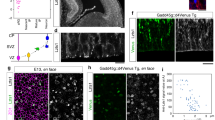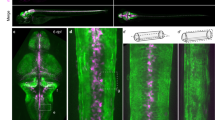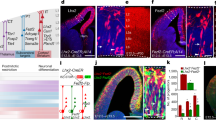Abstract
During corticogenesis, pyramidal neurons (∼80% of cortical neurons) arise from the ventricular zone, pass through a multipolar stage to become bipolar and attach to radial glia1,2, and then migrate to their proper position within the cortex1,3. As pyramidal neurons migrate radially, they remain attached to their glial substrate as they pass through the subventricular and intermediate zones, regions rich in tangentially migrating interneurons and axon fibre tracts. We examined the role of lamellipodin (Lpd), a homologue of a key regulator of neuronal migration and polarization in Caenorhabditis elegans, in corticogenesis. Lpd depletion caused bipolar pyramidal neurons to adopt a tangential, rather than radial-glial, migration mode without affecting cell fate. Mechanistically, Lpd depletion reduced the activity of SRF, a transcription factor regulated by changes in the ratio of polymerized to unpolymerized actin. Therefore, Lpd depletion exposes a role for SRF in directing pyramidal neurons to select a radial migration pathway along glia rather than a tangential migration mode.
This is a preview of subscription content, access via your institution
Access options
Subscribe to this journal
Receive 12 print issues and online access
$209.00 per year
only $17.42 per issue
Buy this article
- Purchase on Springer Link
- Instant access to full article PDF
Prices may be subject to local taxes which are calculated during checkout





Similar content being viewed by others
References
Ayala, R., Shu, T. & Tsai, L. H. Trekking across the brain: the journey of neuronal migration. Cell 128, 29–43 (2007).
Rakic, P. Developmental and evolutionary adaptations of cortical radial glia. Cereb. Cortex 13, 541–549 (2003).
Marin, O. & Rubenstein, J. L. Cell migration in the forebrain. Annu. Rev. Neurosci. 26, 441–483 (2003).
Han, J. et al. Reconstructing and deconstructing agonist-induced activation of integrin αIIbβ3. Curr. Biol. 16, 1796–1806 (2006).
Krause, M. et al. Lamellipodin, an Ena/VASP ligand, is implicated in the regulation of lamellipodial dynamics. Dev. Cell 7, 571–583 (2004).
Lafuente, E. M. et al. RIAM, an Ena/VASP and Profilin ligand, interacts with Rap1-GTP and mediates Rap1-induced adhesion. Dev. Cell 7, 585–595 (2004).
Michael, M., Vehlow, A., Navarro, C. & Krause, M. c-Abl, Lamellipodin, and Ena/VASP proteins cooperate in dorsal ruffling of fibroblasts and axonal morphogenesis. Curr. Biol. 20, 783–791 (2010).
Adler, C. E., Fetter, R. D. & Bargmann, C. I. UNC-6/Netrin induces neuronal asymmetry and defines the site of axon formation. Nat. Neurosci. 9, 511–518 (2006).
Chang, C. et al. MIG-10/lamellipodin and AGE-1/PI3K promote axon guidance and outgrowth in response to slit and netrin. Curr. Biol. 16, 854–862 (2006).
Manser, J. & Wood, W. B. Mutations affecting embryonic cell migrations in Caenorhabditis elegans. Dev. Genet. 11, 49–64 (1990).
Quinn, C. C. et al. UNC-6/netrin and SLT-1/slit guidance cues orient axon outgrowth mediated by MIG-10/RIAM/lamellipodin. Curr. Biol. 16, 845–853 (2006).
Fode, C. et al. A role for neural determination genes in specifying the dorsoventral identity of telencephalic neurons. Genes Dev. 14, 67–80 (2000).
Hand, R. et al. Phosphorylation of Neurogenin2 specifies the migration properties and the dendritic morphology of pyramidal neurons in the neocortex. Neuron 48, 45–62 (2005).
Kriegstein, A. R. & Noctor, S. C. Patterns of neuronal migration in the embryonic cortex. Trends Neurosci. 27, 392–399 (2004).
Yokota, Y. et al. Radial glial dependent and independent dynamics of interneuronal migration in the developing cerebral cortex. PLoS One 2, e794 (2007).
Sanchez-Alcaniz, J. A. et al. Cxcr7 controls neuronal migration by regulating chemokine responsiveness. Neuron 69, 77–90 (2011).
Wang, Y. et al. CXCR4 and CXCR7 have distinct functions in regulating interneuron migration. Neuron 69, 61–76 (2011).
Lyulcheva, E. et al. Drosophila pico and its mammalian ortholog lamellipodin activate serum response factor and promote cell proliferation. Dev. Cell 15, 680–690 (2008).
Miralles, F., Posern, G., Zaromytidou, A. I. & Treisman, R. Actin dynamics control SRF activity by regulation of its coactivator MAL. Cell 113, 329–342 (2003).
Posern, G. & Treisman, R. Actin’ together: serum response factor, its cofactors and the link to signal transduction. Trends Cell Biol. 16, 588–596 (2006).
Johansen, F. E. & Prywes, R. Identification of transcriptional activation and inhibitory domains in serum response factor (SRF) by using GAL4-SRF constructs. Mol. Cell Biol. 13, 4640–4647 (1993).
Posern, G., Sotiropoulos, A. & Treisman, R. Mutant actins demonstrate a role for unpolymerized actin in control of transcription by serum response factor. Mol. Biol. Cell 13, 4167–4178 (2002).
Vartiainen, M. K., Guettler, S., Larijani, B. & Treisman, R. Nuclear actin regulates dynamic subcellular localization and activity of the SRF cofactor MAL. Science 316, 1749–1752 (2007).
Elias, L. A., Turmaine, M., Parnavelas, J. G. & Kriegstein, A. R. Connexin 43 mediates the tangential to radial migratory switch in ventrally derived cortical interneurons. J. Neurosci. 30, 7072–7077 (2010).
Elias, L. A., Wang, D. D. & Kriegstein, A. R. Gap junction adhesion is necessary for radial migration in the neocortex. Nature 448, 901–907 (2007).
Xie, Z. et al. Cep120 and TACCs control interkinetic nuclear migration and the neural progenitor pool. Neuron 56, 79–93 (2007).
Geneste, O., Copeland, J. W. & Treisman, R. LIM kinase and Diaphanous cooperate to regulate serum response factor and actin dynamics. J. Cell Biol. 157, 831–838 (2002).
Schaeren-Wiemers, N. & Gerfin-Moser, A. A single protocol to detect transcripts of various types and expression levels in neural tissue and cultured cells: in situ hybridization using digoxigenin-labelled cRNA probes. Histochemistry 100, 431–440 (1993).
Victorov, I. V. & Krukoff, T. L. Patterns of reaggregation and formation of linear aggregate chains in collagen-well cultures of dissociated mouse brain and spinal cord cells. Brain Res. 198, 167–182 (1980).
Acknowledgements
We thank R. Treisman for providing DNA constructs and R. Hayman for help with graphics. E.M.P. was supported by an NRSA grant F32-GM074507. This work was supported by financial support from a Koch Institute Development award and NIH grant # GM068678 to F.B.G.; L-H.T. is an investigator of Howard Hughes Medical Institute.
Author information
Authors and Affiliations
Contributions
E.M.P. designed experiments, analysed data and wrote the paper. Z.X. designed and carried out experiments. A.L.N. and M.V. carried out experiments. L-H.T. provided advice and commented on the manuscript. E.M.P., Z.X. and F.B.G. discussed the results and implications and commented on the manuscript at all stages. F.B.G. designed experiments, gave technical support and conceptual advice and revised the manuscript.
Corresponding author
Ethics declarations
Competing interests
The authors declare no competing financial interests.
Supplementary information
Supplementary Information
Supplementary Information (PDF 511 kb)
Supplementary Movie 1a
Supplementary Information (MOV 3326 kb)
Supplementary Movie 1b
Supplementary Information (MOV 2540 kb)
Rights and permissions
About this article
Cite this article
Pinheiro, E., Xie, Z., Norovich, A. et al. Lpd depletion reveals that SRF specifies radial versus tangential migration of pyramidal neurons. Nat Cell Biol 13, 989–995 (2011). https://doi.org/10.1038/ncb2292
Received:
Accepted:
Published:
Issue Date:
DOI: https://doi.org/10.1038/ncb2292
This article is cited by
-
Brain specific Lamellipodin knockout results in hyperactivity and increased anxiety of mice
Scientific Reports (2017)
-
MRL proteins cooperate with activated Ras in glia to drive distinct oncogenic outcomes
Oncogene (2017)
-
Stimulus-specific combinatorial functionality of neuronal c-fos enhancers
Nature Neuroscience (2016)
-
Nature and nurture: environmental influences on a genetic rat model of depression
Translational Psychiatry (2016)
-
Decoding the molecular mechanisms of neuronal migration using in utero electroporation
Medical Molecular Morphology (2016)



